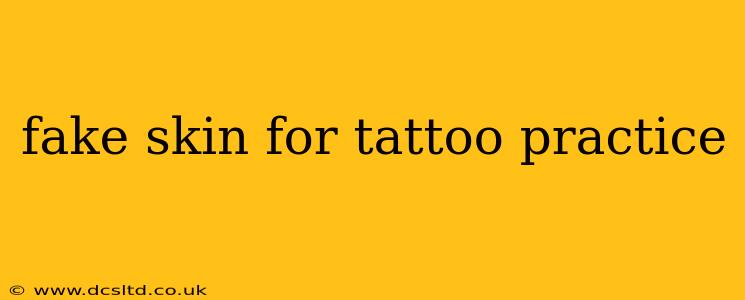Getting your first tattoo is a big decision, and for tattoo artists, perfecting their craft requires countless hours of practice. Fortunately, practicing on fake skin provides a safe and effective way to hone your skills without the risk of harming a client. But with so many options available, choosing the right fake skin for tattoo practice can be overwhelming. This comprehensive guide will delve into the different types of fake skin, their benefits, and how to choose the best one for your needs.
What is Fake Skin for Tattoo Practice?
Fake skin, also known as practice skin or synthetic skin, is a material designed to mimic the texture and feel of human skin. It's used by aspiring and professional tattoo artists to practice various techniques, refine their skills, and experiment with different designs before working on a real client. This allows for error correction, experimentation with shading and linework, and the development of muscle memory without any risk.
What are the Different Types of Fake Skin?
Several types of fake skin cater to different skill levels and practice needs. Here's a breakdown:
Silicone Fake Skin:
- Pros: Offers a realistic feel and texture, closest to human skin; allows for excellent pigment absorption and realistic healing simulation. Often comes in large sheets, allowing for multiple practice sessions.
- Cons: Can be more expensive than other options; requires specific aftercare to maintain its quality.
Latex Fake Skin:
- Pros: Affordable and readily available; provides a decent surface for practice, particularly for beginners.
- Cons: Doesn't mimic human skin as closely as silicone; can be less durable and may tear more easily; absorption of ink may not be as realistic.
Synthetic Fake Skin (Various Materials):
- Pros: Wide range of options with varying textures and thicknesses; often more affordable than silicone; can come in different sizes and forms (sheets, pre-cut shapes).
- Cons: Quality can vary greatly depending on the manufacturer; may not provide the most realistic feel or ink absorption.
How to Choose the Right Fake Skin for Your Needs?
The best fake skin for you depends on your skill level and budget.
-
Beginners: Latex or synthetic fake skin offers a cost-effective way to start practicing basic techniques. Focus on getting comfortable with the machine and hand movements before investing in more expensive silicone skin.
-
Intermediate/Advanced Artists: Silicone fake skin is highly recommended for its realistic feel and ability to simulate the healing process. This allows for more refined practice and helps to perfect techniques for more complex designs.
-
Budget: While silicone is the most realistic, latex and synthetic options provide a more affordable alternative for those on a tighter budget. Consider starting with a smaller sheet to test the quality and suitability before investing in larger quantities.
What are the Benefits of Using Fake Skin for Tattoo Practice?
Practicing on fake skin offers numerous benefits:
- Improved Technique: Allows for endless practice without risking a client's skin.
- Enhanced Confidence: Develops muscle memory and increases confidence before working on real clients.
- Cost-Effective: Prevents costly mistakes and potential client dissatisfaction.
- Experimentation: Allows for experimentation with different techniques, styles, and designs.
- Safety: Eliminates the risk of infection, cross-contamination, and other potential health hazards.
How to Care for Fake Skin After Use?
Proper care will prolong the lifespan of your fake skin. Always refer to the manufacturer's instructions for specific cleaning and storage guidelines. However, general care often involves cleaning with soap and water, thoroughly drying it, and storing it in a cool, dry place.
What type of tattoo needles should I use on fake skin?
The same type of needles used on human skin can be used for practicing on fake skin. Remember to always use sterile needles and follow proper hygiene practices.
Is it necessary to sterilize fake skin?
While you don't need to sterilize fake skin in the same way you would sterilize human skin, practicing good hygiene is crucial. Clean the surface before and after each practice session.
Where can I buy fake skin for tattoo practice?
Fake skin is readily available online from various retailers and tattoo supply stores. Consider reading reviews and comparing prices before purchasing.
This guide provides a comprehensive overview of fake skin for tattoo practice. Remember, consistent practice and the right tools are essential for mastering the art of tattooing. By using fake skin effectively, you can refine your skills and build confidence before taking on the responsibility of tattooing clients.
